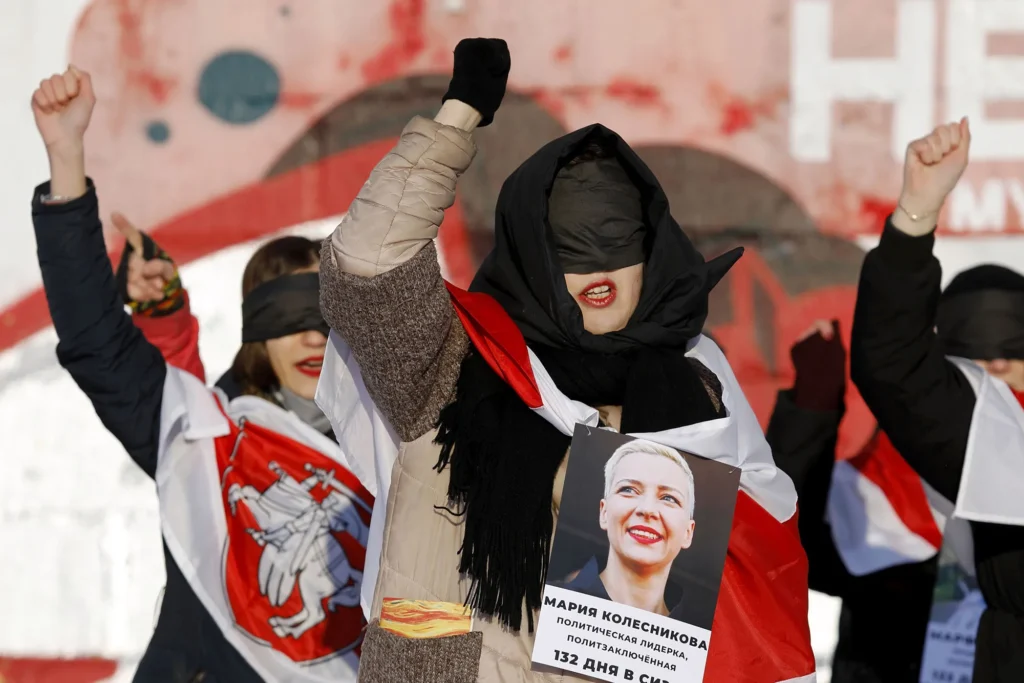Belarus Resistance Art - How Artists Resist: Music, Graffiti and Subversion

In Belarus, resistance, art and freedom does not always come in the form of protests in the streets. For decades, art has been a silent — and sometimes loud — weapon against repression. From underground rock bands in the late Soviet era to bold street murals painted in the dead of night, creative expression has become a coded language of dissent. In 2025, as censorship tightens and authoritarian control persists, Belarusian artists continue to find ways to challenge the regime through music, graffiti and other forms of subversion.
🎶 Music as a Voice of Defiance
Music has long been a tool for unity and rebellion in Belarus. In the 1980s, underground rock bands like Mroja used metaphor-filled lyrics to criticise the Soviet system without naming it outright. This tradition carried into the 2000s with bands such as Lyapis Trubetskoy, whose satirical songs and anti-authoritarian anthems were banned from state media but spread widely through bootleg recordings and online sharing.
Today, new generations of musicians are continuing the fight. Hip-hop artists rap about life under surveillance, indie singers weave stories of exile, and folk musicians revive traditional songs with lyrics adapted to reflect modern struggles. While many have been forced to perform abroad due to government pressure, their music still finds its way back into Belarus via VPNs, encrypted platforms, and social media.
One standout example is the band Dzieciuki, which blends punk energy with historical themes, reminding Belarusians of past resistance movements. By connecting current political struggles with moments of national pride, they help keep the spirit of resistance alive.
🎨 Graffiti: Painting the Truth on City Walls
In a country where independent media is suppressed, the streets have often become a newspaper of resistance. Graffiti and street art in Belarus carry powerful political messages — sometimes symbolic, sometimes direct.
During the 2020 protests, images of white-red-white flags, portraits of political prisoners, and slogans calling for freedom appeared overnight across Minsk, Hrodna, and Brest. The state responded with rapid “clean-up crews” and heavy penalties for anyone caught in the act, but the cycle continues: graffiti erased in the morning often reappears by the evening.
Even when direct slogans are dangerous, artists use symbolism to communicate. A single painted flower, a clenched fist, or subtle colour patterns can carry political meaning understood by the public but overlooked by outsiders. This silent code allows dissent to survive in plain sight.
Beyond music and street art, writers and playwrights have also resisted through subtle storytelling. Plays staged in small, unofficial venues explore themes of freedom and oppression through allegory, while poets use double meanings to bypass censorship.
In recent years, samizdat (self-published works) has returned as a tool of resistance — books and zines are printed abroad, then smuggled into Belarus or distributed digitally to avoid state control.

📱 The Digital Shift in 2025
With the regime tightening control over physical public spaces, much of Belarusian resistance art has moved online. Instagram accounts, Telegram channels, and encrypted art collectives share digital posters, music videos, and illustrated essays that travel far beyond the borders.
Artists in exile collaborate with those still in Belarus, producing works that can be printed at home, projected onto buildings, or even shared as augmented reality (AR) experiences accessible through smartphones.
This shift to digital not only keeps the art alive but also makes it harder for authorities to erase. A deleted mural can be scrubbed from a wall — but a viral image can live forever on the internet.
⚖ The Risk of Being an Artist in Belarus
Artistic resistance comes at a high cost. Musicians have been blacklisted from venues, graffiti artists fined or jailed, and writers subjected to interrogations. Cultural spaces suspected of hosting political events have been shut down.
Despite the dangers, many artists persist, seeing their work not just as self-expression but as a moral responsibility to their community.
🔥 Why Art Matters in the Struggle for Freedom
Art reaches where speeches cannot. It bypasses formal politics and speaks directly to emotions, building solidarity in subtle ways. In a repressive environment, art keeps the memory of freedom alive, even for those too afraid to protest openly.
The Belarusian resistance art movement shows that culture is not just entertainment — it is a battlefield. And in that battlefield, a song, a mural, or a poem can be as powerful as any protest march.
❓ FAQs – Belarus Resistance Art
1. Why is art important in Belarus’s resistance movement?
Art provides a way to express dissent and preserve cultural identity when political expression is heavily restricted. It unites communities, spreads awareness, and inspires action.
2. How do Belarusian artists avoid censorship?
Many use symbolism, coded messages, or work anonymously. Others share their art online using VPNs and encrypted channels to reach audiences safely.
3. What are common symbols in Belarus resistance art?
The white-red-white flag, flowers, clenched fists, and historical references are common motifs. These often hold deep cultural and political meaning.
4. Are there risks for artists involved in political expression?
Yes. Artists face fines, imprisonment, blacklisting, and harassment. Many have been forced into exile to continue their work safely.
5. How can I support Belarusian resistance artists?
Follow their work on secure platforms, share their art, attend international exhibitions, and support NGOs that defend artistic freedom.
